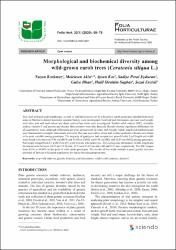Morphological and biochemical diversity among wild-grown carob trees (Ceratonia siliqua L.)

View/
Date
2020Author
Korkmaz, NazanAkın, Melekşen
Koç, Aysen
Eyduran, Şadiye Peral
İlhan, Gülce
Sağbaş, Halil Ibrahim
Ercişli, Sezai
Metadata
Show full item recordAbstract
Tree, leaf, pod and seed morphology, as well as pod biochemistry of 36 wild-grown carob genotypes sampled from rural areas in Marmaris district located at western Turkey, were investigated. Leaf and pod dimensions, pod and seed weight, seed ratio, pod and seed colour and shape and surface traits were investigated. Soluble solid content (SSC), titratable acidity, vitamin C and protein and dietary fibre contents were also detected. Results showed significant differences for all quantitative traits, although differences are more pronounced for some pod (weight, width, length and thickness) and seed characteristics (weight, dimensions and ratio). Pod and seed colour, shape and surface qualitative threats were found to be quite variable among genotypes. The majority of genotypes had an open tree growth habit. Leaf length and width were found to be between 8.04 cm (M19) and 11.60 cm (M12) and 8.40 cm (M2) and 12.04 cm (M12) among genotypes. Pod weight ranged from 8.3 g (M35) to 29.5 g (M3) in the wild genotypes. The average pod dimensions (width, length and thickness) were between 14.27 and 23.38 nun, 12.54 and 21.67 cm and 4.80 and 8.37 mm, respectively. The SSC ranged from 49.36 to 69.36% in the pods of wild carob genotypes. The results of this study indicate a good genetic resource potential of Turkish wild carob populations for future breeding programmes.

















